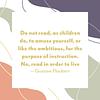Take a photo of a barcode or cover
I listened to this book on audio. Had I read the book, I believe I may have rated it even higher. This is no reflection on the narrator, it's a personal preference. I find when I listen to an audio book, I have a hard time keeping the same pace as the narrator and don't absorb the same level of detail that I would if I were reading the story myself. Overall, however, I think it was an excellent novel and if I find a used copy sometime in the future, would probably re-read it in book form where I can better savor the many layers of this story.
This book was a wonderful read for my first book of 2017! It was easy to get swept up in the world of Sara de Vos in Holland in the 1630s (very hard times), and in part of the world of art forgery in Brooklyn in the 1950s, and in the art museum world of 2000 as the original de Vos and the fake de Vos are set on a collision course!
I especially loved some of the details involved with making authentic paints, canvases, glue etc from the 1600s - and that people trying the recreate a period piece need to render their own rabbit pelts - I bet that makes for a not-so-pleasant aroma!
I felt great sympathy with Ellie - I know I did silly things in my 20s, but nothing that I can imagine would come back to affect me 40 years later!
I added this book because of an episode of ABC’s The Book Club when it was discussed (http://www.abc.net.au/tv/firsttuesday/s4453040.htm) however if you are going to read this soon and would like to watch The Book Club episode, I would suggest not watching the episode until you’ve read the book - there are mild spoilers. 4.5★
I especially loved some of the details involved with making authentic paints, canvases, glue etc from the 1600s - and that people trying the recreate a period piece need to render their own rabbit pelts - I bet that makes for a not-so-pleasant aroma!
I felt great sympathy with Ellie - I know I did silly things in my 20s, but nothing that I can imagine would come back to affect me 40 years later!
I added this book because of an episode of ABC’s The Book Club when it was discussed (http://www.abc.net.au/tv/firsttuesday/s4453040.htm) however if you are going to read this soon and would like to watch The Book Club episode, I would suggest not watching the episode until you’ve read the book - there are mild spoilers. 4.5★
adventurous
mysterious
relaxing
medium-paced
Strong character development:
No
Loveable characters:
No
Diverse cast of characters:
No
Flaws of characters a main focus:
No
It's only a 3 star rating and not a 4 star because I listened to the audio book, and had major issues with the pronunciation of the Dutch names and phrases. All 4 of my grandparents were native Dutch speakers. There were a few instances where I actually went back to the print book to figure what a name was supposed to have been i.e. Kathrijn is Katrine with a long i sound, decidedly NOT the same as Kathryn. There's no th sound either; it's a hard dentil T sound.
I listened to the audiobook version, so I'll split my review in two.
The story was good, with some excellent language to keep you going through what is a fairly dry subject matter, focusing on the characters around a painting rather than the artwork itself. For a character-driven story, I often found myself not understanding the characters and their motivations, and I got the distinct feeling the author didn't quite know either. I still enjoyed it, and it left it off with enough questions that you could launch a conversation about it easily. I suppose that's part of the charm. If a book has had no impact on you, then you often will never speak of it again. This left me wanting to talk about it, so in the end, I would recommend it, and there's a character for everyone to either like or relate to in some fashion.
That said, do not listen to THIS audiobook. Edoardo Ballerini should be fired. If you look up the audible reviews for this version, all you will see are a swath of reviews begging for someone who has actually heard an Australian speak before. One of the three main characters is from Sydney, one of the three main locations within the story IS Sydney. You could be forgiven for thinking they'd changed planet altogether, with the odd Scottish/South African/Irish/English mix that is thrown together whenever the narrator is trying to get an 'ossy' (Aussie) accent. It was almost impossible to listen to, it was truly terrible. How did this happen?
The story was good, with some excellent language to keep you going through what is a fairly dry subject matter, focusing on the characters around a painting rather than the artwork itself. For a character-driven story, I often found myself not understanding the characters and their motivations, and I got the distinct feeling the author didn't quite know either. I still enjoyed it, and it left it off with enough questions that you could launch a conversation about it easily. I suppose that's part of the charm. If a book has had no impact on you, then you often will never speak of it again. This left me wanting to talk about it, so in the end, I would recommend it, and there's a character for everyone to either like or relate to in some fashion.
That said, do not listen to THIS audiobook. Edoardo Ballerini should be fired. If you look up the audible reviews for this version, all you will see are a swath of reviews begging for someone who has actually heard an Australian speak before. One of the three main characters is from Sydney, one of the three main locations within the story IS Sydney. You could be forgiven for thinking they'd changed planet altogether, with the odd Scottish/South African/Irish/English mix that is thrown together whenever the narrator is trying to get an 'ossy' (Aussie) accent. It was almost impossible to listen to, it was truly terrible. How did this happen?
This was an enjoyable read. It’s broken into 3 time periods and told with skill and detail. The characters feel very real and human.
Poignant, layered masterpiece on ageing and the lost promise of youth.
A historical novel revolving between the 17th century (time of Sara De Vos life), the 1950's NYC and 2000 Australia (times of art restorer/painter Ellie Shipley and Marty de Groot, the owner of a painting by Sara de Vos). The author segues between time periods, expertly weaving the three eras together and creating three wonderful characters in the telling. I loved the end of their stories.
Well, well, what do you know? I've managed to finish an audiobook. I was planning to read the ebook I'd purchased a few months back. Then I came across an audiobook at the local library and I couldn't pass the opportunity.
I am so thrilled to have managed to finish my first audiobook. There I was stating loud and clearly that audiobooks weren't for me. Maybe the problem were the books and/or the narrators? Or timing? Regardless, I'm thrilled to bits.
The Last Painting of Sara de Vos really appealed to me in all aspects. As I stated before, I love art. In my early twenties, I used to be quite taken with the Dutch and the Flemish painters. So it was really nice to delve back into the Ducth art world. Smith's descriptions were so gorgeous and so rich, I could easily imagine the locations and the paintings.
The novel switches between the XVII century Netherlands, where Sara de Vos is the main character, and the late XX century and the beginning of the XXI century, where we encounter the Australian, Ellie Shipley, an austere woman, a talented painter, who becomes an art restorator, curator, and teacher. The travels between different eras are easy to follow, as each chapter starts with the year and location, so I was never confused as to where I was and whose story I was listening to.
While the plot is interesting and well done, what I enjoyed the most about this novel were the superb characterisations, which captured so well the inner worlds of Sara de Vos, Ellie Shipley and some of other secondary characters.
Yes, this is about art, but also about so much more: about creating art, about the art world, about the struggle between the creative and the every-day life, and not lastly, about the double standards when it comes to men and women.
I can go on and on about this novel, but there are so many better reviews out there.
I would be remiss not to mention the wonderful narrator of this audiobook, Edoardo Ballerini. My, what a talented narrator. His voice is splendid, his intonation and accent renditions are just wonderful.
So, I am happy to conclude that the hype was well deserved.
I am so thrilled to have managed to finish my first audiobook. There I was stating loud and clearly that audiobooks weren't for me. Maybe the problem were the books and/or the narrators? Or timing? Regardless, I'm thrilled to bits.
The Last Painting of Sara de Vos really appealed to me in all aspects. As I stated before, I love art. In my early twenties, I used to be quite taken with the Dutch and the Flemish painters. So it was really nice to delve back into the Ducth art world. Smith's descriptions were so gorgeous and so rich, I could easily imagine the locations and the paintings.
The novel switches between the XVII century Netherlands, where Sara de Vos is the main character, and the late XX century and the beginning of the XXI century, where we encounter the Australian, Ellie Shipley, an austere woman, a talented painter, who becomes an art restorator, curator, and teacher. The travels between different eras are easy to follow, as each chapter starts with the year and location, so I was never confused as to where I was and whose story I was listening to.
While the plot is interesting and well done, what I enjoyed the most about this novel were the superb characterisations, which captured so well the inner worlds of Sara de Vos, Ellie Shipley and some of other secondary characters.
Yes, this is about art, but also about so much more: about creating art, about the art world, about the struggle between the creative and the every-day life, and not lastly, about the double standards when it comes to men and women.
I can go on and on about this novel, but there are so many better reviews out there.
I would be remiss not to mention the wonderful narrator of this audiobook, Edoardo Ballerini. My, what a talented narrator. His voice is splendid, his intonation and accent renditions are just wonderful.
So, I am happy to conclude that the hype was well deserved.
The Last Painting of Sara de Vos tells two stories. The first, set in 1631, is the story of Sara de Vos, the first woman to be admitted as a master painter to the Guild of St. Luke’s in Holland. The second, set roughly from the 1950s to the 2000s, follows Ellie and Marty alternately as they are both embroiled in an art scandal related to the forgery of the last painting attributed to Sara de Vos.
Sara’s story was actually rather interesting. Following her from a tragic turning point in her life, to painting the work that will ultimately become the central focus of the entire story, and finally to the end of her days. I could have done with more of Sara’s story and less of Ellie’s. Sara was an interesting and layered character for how little page time she got.
The majority of the story focuses on Ellie and Marty and their intertwined story. I found Marty to be down right unlikeable and not in the I’m supposed to not like him way. He’s an entitled man who thinks he can use anonymity and money to get everything he wants. It was uncomfortable to read, and I don’t feel like, however weakly the author tried, his predatory actions were ever properly discussed or explored.
Ellie was just unmemorable. She felt like a stock character that Smith needed to build the story that he wanted to tell. She’s needlessly quirky and everything about her just screamed of plot point convenience.
I was seriously underwhelmed by this one. I usually like historical fiction with two interconnected timelines, and especially those centering around mysteries of the art world. This one just did not deliver anywhere near what I was hoping for. It felt muddled and many scenes left me feeling either underwhelmed or icky.
Sara’s story was actually rather interesting. Following her from a tragic turning point in her life, to painting the work that will ultimately become the central focus of the entire story, and finally to the end of her days. I could have done with more of Sara’s story and less of Ellie’s. Sara was an interesting and layered character for how little page time she got.
The majority of the story focuses on Ellie and Marty and their intertwined story. I found Marty to be down right unlikeable and not in the I’m supposed to not like him way. He’s an entitled man who thinks he can use anonymity and money to get everything he wants. It was uncomfortable to read, and I don’t feel like, however weakly the author tried, his predatory actions were ever properly discussed or explored.
Ellie was just unmemorable. She felt like a stock character that Smith needed to build the story that he wanted to tell. She’s needlessly quirky and everything about her just screamed of plot point convenience.
I was seriously underwhelmed by this one. I usually like historical fiction with two interconnected timelines, and especially those centering around mysteries of the art world. This one just did not deliver anywhere near what I was hoping for. It felt muddled and many scenes left me feeling either underwhelmed or icky.



